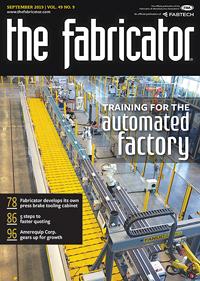Principal
- FMA
- The Fabricator
- FABTECH
- Canadian Metalworking
Categories
- Additive Manufacturing
- Aluminum Welding
- Arc Welding
- Assembly and Joining
- Automation and Robotics
- Bending and Forming
- Consumables
- Cutting and Weld Prep
- Electric Vehicles
- En Español
- Finishing
- Hydroforming
- Laser Cutting
- Laser Welding
- Machining
- Manufacturing Software
- Materials Handling
- Metals/Materials
- Oxyfuel Cutting
- Plasma Cutting
- Power Tools
- Punching and Other Holemaking
- Roll Forming
- Safety
- Sawing
- Shearing
- Shop Management
- Testing and Measuring
- Tube and Pipe Fabrication
- Tube and Pipe Production
- Waterjet Cutting
Industry Directory
Webcasts
Podcasts
FAB 40
Advertise
Subscribe
Account Login
Search
How the book study complements lean manufacturing
Unleash the many benefits of the book study
- By Jeff Sipes
- September 13, 2019
- Article
- Shop Management
Continuous improvement calls for continual learning. But in a world of finite resources, you need to make the most out of what you have. How do you get people in your organization on the same page? How do you know how much people really know about the philosophies and methods behind lean manufacturing and other improvement initiatives? How do you do all of this while you still keep the business going?
One way doesn’t involve fancy software or machinery, just access to a bookseller and time to read and discuss. It’s the book study. This isn’t a casual book club, though. For a book study to be effective and meaningful, it needs purpose and structure.
Business Case for the Book Study
As with any other business decision, you need a reason for and benefit from the investment of time and resources a book study requires. If you approach the book study objectively, you’ll find its business case to be quite compelling.
First, it’s cost-effective. Instead of sending a team outside to training and incur the cost of travel, lodging, and time spent away from the operation, you can do it in-house. You just need a few copies of the targeted book, the participants’ time in the book study meetings, and someone to facilitate and coordinate. A book study has minimal out-of-pocket costs.
The topics can be as wide or as narrow as you want. You determine the topic and identify the book to support the study, depending on the audience and the business issue, be it broad and general or deep and specific. A seasoned facilitator will help the study group find the appropriate balance.
Be sure to match the book with the right audience. A book study group could include front-line employees, supervisors, middle managers, senior management, or a mix of all four.
For instance, Lean Thinking by Jim Womack and Dan Jones focuses on a general understanding of five principles: value, value stream, flow, pull, and perfection; it targets senior and middle management. Faster Cheaper Better by Michael Hammer and Lisa Hershman also targets senior and middle management and focuses on developing and executing business processes. Turn the Ship Around! by L. David Marquet has a similar target audience and focuses on developing accountability and ownership.
In their book The Gold Mine, authors Freddy Balle and Michael Balle use a hypothetical case study to illustrate how a plant can operationally transform itself. The authors target middle management, front-line management, and front-line employees.
Know that just because a book targets a certain audience doesn’t mean others get nothing out of it. And the targeted audience is just a generalization. Which books you choose depends on your company’s structure, culture, and goals.
The book study provides a venue to see how the team works together, identifies similarities and differences among people, and allows team members to better understand each other. You should expect the team to be more cohesive, to be better at leveraging each other’s strengths, and to become more effective problem-solvers.
Book study groups should have between five and 12 participants. A group too small might have limited discussions, while a group that’s too large can lead to an unwieldy session where people can hide in the crowd.
You control the pace. You can divide the study into sections and write targeted questions for each. And because you are expecting everyone to discuss those targeted questions, they will need time between book study sessions to read the book. Perhaps space the sessions out a week or two apart, but do not let the book study drag on. The entire study of a particular book should take no longer than two months.
The Book Study, Step by Step
Book studies can be tremendously beneficial. They don’t cost much, and you can tailor the effort to meet your specific needs. That said, by now you know that standard work is important, and standard work applies to the book study process too.
Does a book study fit your company? First decide whether a book study makes sense for you and develop a business case. Continual learning is of course a lean manufacturing fundamental. But you can approach learning in various ways—and the book study just happens to be one of them. Before launching a book study, be sure it fits your company’s DNA.
Determine the topics and the audience. The book study is particularly effective for senior and middle management. As part of your annual planning for improvement initiatives, identify topics and participants for book studies you’d like to conduct. If you are in the early stages of lean implementation, then Lean Thinking might be a great topic for your leadership team.
Develop a study guide. For each book, develop a study guide with relevant questions for each session. Each session will likely cover multiple chapters, so the session’s questions should represent whatever chapters are included.
Schedule the sessions. Send the books and the study guide out to the participants about two weeks ahead of the first session. Two weeks should be ample time for everyone to do the reading and develop answers to the questions for that session.
If you are farther along, then Faster Cheaper Better might be appropriate as you evolve from spot improvement projects to a value-stream and business-process focus. This becomes especially important when you implement information-based, transactional, or in-between processes. These can include tasks involving logistics, document control, customer approvals, or other processes that occur in between physical operations.
When you conduct the session, target 90 minutes for a focused discussion. Use a combination of structured “go around the room one-by-one” to get input from everyone—remember, nobody can hide in these sessions—and open, freewheeling discussion. Participants should leave with an understanding of the topics, appreciation for each other’s unique perspectives, and a gauge on where each person needs to dig deeper for particular knowledge.
Role of a Strong Facilitator
A strong facilitator can make or break a book study. He or she will keep the group on track in terms of topics, level of discussion, and time. The facilitator should push, probe, and, when the discussion gets tense, carefully navigate the group toward understanding rather than animosity.
Facilitators should not be participants. They should instead help participants take the book study seriously and help foster open, honest, and constructive discussions.
A senior management book study group might work with the president or another executive, like a human resources VP, as a facilitator. Still, these people or other upper-level managers—through no fault of their own—might hamper participation or indirectly affect the group. People say what they think the boss wants to hear.
If possible, use an outsider to facilitate the study group. That might be your internal continuous improvement person, a manager or leader from a different part of the organization, or a consultant or adviser. The key is that everyone understands the facilitator’s role.
Little Risk, Great Potential
Imagine four of your supervisors and six of your lead production people in a study session for The Gold Mine. They exchange ideas about flow, constraints, personnel relationships, and how to successfully satisfy the customer. And the facilitator helps everyone understand different perspectives. People carry this knowledge with them. They generate ideas and solve problems—and none of it would have happened without their book study experience.
Imagine your leadership team engaged in a session about Faster Cheaper Better. They discuss how organizational silos can negatively affect overall end-to-end processes and customer satisfaction. The director of supply chain has a better understanding of how she affects operations. The director of engineering now appreciates how output affects the performance of the people who build products.
The person who isn’t onboard, who hasn’t really wanted anything to do with this lean stuff, comes to a realization. He either needs to get with the program or move on. An effective facilitator will help deal with this and similar issues.
All these benefits are just the tip of the iceberg. Few initiatives in business have so much potential and so little risk. Give the targeted book study a try. It has very little downside and tremendous upside.Jeff Sipes is principal of Back2Basics LLC, 317-439-7960, www.back2basics-lean.com. If you have improvement ideas you’d like to read about, email him at jwsipes@back2basics-lean.com or Senior Editor Tim Heston at timh@thefabricator.com.
About the Author

Jeff Sipes
9250 Eagle Meadow Dr.
Indianapolis, IN 46234
(317) 439-7960
subscribe now

The Fabricator is North America's leading magazine for the metal forming and fabricating industry. The magazine delivers the news, technical articles, and case histories that enable fabricators to do their jobs more efficiently. The Fabricator has served the industry since 1970.
start your free subscription- Stay connected from anywhere

Easily access valuable industry resources now with full access to the digital edition of The Fabricator.

Easily access valuable industry resources now with full access to the digital edition of The Welder.

Easily access valuable industry resources now with full access to the digital edition of The Tube and Pipe Journal.
- Podcasting
- Podcast:
- The Fabricator Podcast
- Published:
- 04/16/2024
- Running Time:
- 63:29
In this episode of The Fabricator Podcast, Caleb Chamberlain, co-founder and CEO of OSH Cut, discusses his company’s...
- Trending Articles
Tips for creating sheet metal tubes with perforations

Are two heads better than one in fiber laser cutting?

Supporting the metal fabricating industry through FMA

JM Steel triples capacity for solar energy projects at Pennsylvania facility

Omco Solar opens second Alabama manufacturing facility

- Industry Events
16th Annual Safety Conference
- April 30 - May 1, 2024
- Elgin,
Pipe and Tube Conference
- May 21 - 22, 2024
- Omaha, NE
World-Class Roll Forming Workshop
- June 5 - 6, 2024
- Louisville, KY
Advanced Laser Application Workshop
- June 25 - 27, 2024
- Novi, MI



























